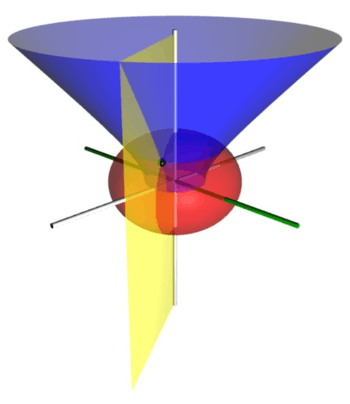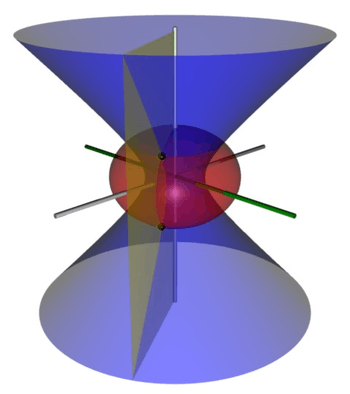Oblate spheroidal coordinates

Oblate spheroidal coordinates are a three-dimensional orthogonal coordinate system that results from rotating the two-dimensional elliptic coordinate system about the non-focal axis of the ellipse, i.e., the symmetry axis that separates the foci. Thus, the two foci are transformed into a ring of radius  in the x-y plane. (Rotation about the other axis produces prolate spheroidal coordinates.) Oblate spheroidal coordinates can also be considered as a limiting case of ellipsoidal coordinates in which the two largest semi-axes are equal in length.
in the x-y plane. (Rotation about the other axis produces prolate spheroidal coordinates.) Oblate spheroidal coordinates can also be considered as a limiting case of ellipsoidal coordinates in which the two largest semi-axes are equal in length.
Oblate spheroidal coordinates are often useful in solving partial differential equations when the boundary conditions are defined on an oblate spheroid or a hyperboloid of revolution. For example, they played an important role in the calculation of the Perrin friction factors, which contributed to the awarding of the 1926 Nobel Prize in Physics to Jean Baptiste Perrin. These friction factors determine the rotational diffusion of molecules, which affects the feasibility of many techniques such as protein NMR and from which the hydrodynamic volume and shape of molecules can be inferred. Oblate spheroidal coordinates are also useful in problems of electromagnetism (e.g., dielectric constant of charged oblate molecules), acoustics (e.g., scattering of sound through a circular hole), fluid dynamics (e.g., the flow of water through a firehose nozzle) and the diffusion of materials and heat (e.g., cooling of a red-hot coin in a water bath)
Definition (μ, ν, φ)

The most common definition of oblate spheroidal coordinates (μ, ν, φ) is
where μ is a nonnegative real number and the angle ν lies between ±90°. The azimuthal angle φ can fall anywhere on a full circle, between ±180°. These coordinates are favored over the alternatives below because they are not degenerate; the set of coordinates (μ, ν, φ) describes a unique point in Cartesian coordinates (x, y, z). The reverse is also true, except on the z-axis and the disk in the x-y plane inside the focal ring.
Coordinate surfaces
The surfaces of constant μ form oblate spheroids, by the trigonometric identity
since they are ellipses rotated about the z-axis, which separates their foci. An ellipse in the x-z plane (Figure 2) has a major semiaxis of length a cosh μ along the x-axis, whereas its minor semiaxis has length a sinh μ along the z-axis. The foci of all the ellipses in the x-z plane are located on the x-axis at ±a.
Similarly, the surfaces of constant ν form one-sheet half hyperboloids of revolution by the hyperbolic trigonometric identity
For positive ν, the half-hyperboloid is above the x-y plane (i.e., has positive z) whereas for negative ν, the half-hyperboloid is below the x-y plane (i.e., has negative z). Geometrically, the angle ν corresponds to the angle of the asymptotes of the hyperbola. The foci of all the hyperbolae are likewise located on the x-axis at ±a.
Inverse transformation
The (μ, ν, φ) coordinates may be calculated from the Cartesian coordinates (x, y, z) as follows. The azimuthal angle φ is given by the formula
The cylindrical radius ρ of the point P is given by
and its distances to the foci in the plane defined by φ is given by
The remaining coordinates μ and ν can be calculated from the equations
where the sign of μ is always non-negative, and the sign of ν is the same as that of z.
Another method to compute the inverse transform is
where
Scale factors
The scale factors for the coordinates μ and ν are equal
whereas the azimuthal scale factor equals
Consequently, an infinitesimal volume element equals
and the Laplacian can be written
Other differential operators such as  and
and  can be expressed in the coordinates (μ, ν, φ) by substituting the scale factors into the general formulae found in orthogonal coordinates.
can be expressed in the coordinates (μ, ν, φ) by substituting the scale factors into the general formulae found in orthogonal coordinates.
Basis Vectors
The orthonormal basis vectors for the  coordinate system can be expressed in Cartesian coordinates as
coordinate system can be expressed in Cartesian coordinates as
where  are the Cartesian unit vectors. Here,
are the Cartesian unit vectors. Here,  is the outward normal vector to the oblate spheroidal surface of constant
is the outward normal vector to the oblate spheroidal surface of constant  ,
,  is the same azimuthal unit vector from spherical coordinates, and
is the same azimuthal unit vector from spherical coordinates, and  lies in the tangent plane to the oblate spheroid surface and completes the right-handed basis set.
lies in the tangent plane to the oblate spheroid surface and completes the right-handed basis set.
Definition (ζ, ξ, φ)
Another set of oblate spheroidal coordinates  are sometimes used where
are sometimes used where  and
and  (Smythe 1968). The curves of constant
(Smythe 1968). The curves of constant  are oblate spheroids and the curves of constant
are oblate spheroids and the curves of constant  are the hyperboloids of revolution. The coordinate
are the hyperboloids of revolution. The coordinate  is restricted by
is restricted by  and
and  is restricted by
is restricted by  .
.
The relationship to Cartesian coordinates is
Scale factors
The scale factors for  are:
are:
Knowing the scale factors, various functions of the coordinates can be calculated by the general method outlined in the orthogonal coordinates article. The infinitesimal volume element is:
The gradient is:
The divergence is:
and the Laplacian equals
Oblate spheroidal harmonics
- See also Oblate spheroidal wave function.
As is the case with spherical coordinates and spherical harmonics, Laplace's equation may be solved by the method of separation of variables to yield solutions in the form of oblate spheroidal harmonics, which are convenient to use when boundary conditions are defined on a surface with a constant oblate spheroidal coordinate.
Following the technique of separation of variables, a solution to Laplace's equation is written:
This yields three separate differential equations in each of the variables:
where m is a constant which is an integer because the φ variable is periodic with period 2π. n will then be an integer. The solution to these equations are:
where the  are constants and
are constants and  and
and  are associated Legendre polynomials of the first and second kind respectively. The product of the three solutions is called an oblate spheroidal harmonic and the general solution to Laplace's equation is written:
are associated Legendre polynomials of the first and second kind respectively. The product of the three solutions is called an oblate spheroidal harmonic and the general solution to Laplace's equation is written:
The constants will combine to yield only four independent constants for each harmonic.
Definition (σ, τ, φ)

An alternative and geometrically intuitive set of oblate spheroidal coordinates (σ, τ, φ) are sometimes used, where σ = cosh μ and τ = cos ν.[1] Therefore, the coordinate σ must be greater than or equal to one, whereas τ must lie between ±1, inclusive. The surfaces of constant σ are oblate spheroids, as were those of constant μ, whereas the curves of constant τ are full hyperboloids of revolution, including the half-hyperboloids corresponding to ±ν. Thus, these coordinates are degenerate; two points in Cartesian coordinates (x, y, ±z) map to one set of coordinates (σ, τ, φ). This two-fold degeneracy in the sign of z is evident from the equations transforming from oblate spheroidal coordinates to the Cartesian coordinates
The coordinates  and
and  have a simple relation to the distances to the focal ring. For any point, the sum
have a simple relation to the distances to the focal ring. For any point, the sum  of its distances to the focal ring equals
of its distances to the focal ring equals  , whereas their difference
, whereas their difference  equals
equals  . Thus, the "far" distance to the focal ring is
. Thus, the "far" distance to the focal ring is  , whereas the "near" distance is
, whereas the "near" distance is  .
.
Coordinate surfaces
Similar to its counterpart μ, the surfaces of constant σ form oblate spheroids
Similarly, the surfaces of constant τ form full one-sheet hyperboloids of revolution
Scale factors
The scale factors for the alternative oblate spheroidal coordinates  are
are
whereas the azimuthal scale factor is  .
.
Hence, the infinitesimal volume element can be written
and the Laplacian equals
Other differential operators such as  and
and  can be expressed in the coordinates
can be expressed in the coordinates  by substituting the scale factors into the general formulae found in orthogonal coordinates.
by substituting the scale factors into the general formulae found in orthogonal coordinates.
As is the case with spherical coordinates, Laplaces equation may be solved by the method of separation of variables to yield solutions in the form of oblate spheroidal harmonics, which are convenient to use when boundary conditions are defined on a surface with a constant oblate spheroidal coordinate (See Smythe, 1968).
References
- ↑ Abramowitz and Stegun, p. 752.
Bibliography
No angles convention
- Morse PM, Feshbach H (1953). Methods of Theoretical Physics, Part I. New York: McGraw-Hill. p. 662. Uses ξ1 = a sinh μ, ξ2 = sin ν, and ξ3 = cos φ.
- Zwillinger D (1992). Handbook of Integration. Boston, MA: Jones and Bartlett. p. 115. ISBN 0-86720-293-9. Same as Morse & Feshbach (1953), substituting uk for ξk.
- Smythe, WR (1968). Static and Dynamic Electricity (3rd ed.). New York: McGraw-Hill.
- Sauer R, Szabó I (1967). Mathematische Hilfsmittel des Ingenieurs. New York: Springer Verlag. p. 98. LCCN 67025285. Uses hybrid coordinates ξ = sinh μ, η = sin ν, and φ.
Angle convention
- Korn GA, Korn TM (1961). Mathematical Handbook for Scientists and Engineers. New York: McGraw-Hill. p. 177. LCCN 59014456. Korn and Korn use the (μ, ν, φ) coordinates, but also introduce the degenerate (σ, τ, φ) coordinates.
- Margenau H, Murphy GM (1956). The Mathematics of Physics and Chemistry. New York: D. van Nostrand. p. 182. LCCN 55010911. Like Korn and Korn (1961), but uses colatitude θ = 90° - ν instead of latitude ν.
- Moon PH, Spencer DE (1988). "Oblate spheroidal coordinates (η, θ, ψ)". Field Theory Handbook, Including Coordinate Systems, Differential Equations, and Their Solutions (corrected 2nd ed., 3rd print ed.). New York: Springer Verlag. pp. 31–34 (Table 1.07). ISBN 0-387-02732-7. Moon and Spencer use the colatitude convention θ = 90° - ν, and rename φ as ψ.
Unusual convention
- Landau LD, Lifshitz EM, Pitaevskii LP (1984). Electrodynamics of Continuous Media (Volume 8 of the Course of Theoretical Physics) (2nd ed.). New York: Pergamon Press. pp. 19–29. ISBN 978-0-7506-2634-7. Treats the oblate spheroidal coordinates as a limiting case of the general ellipsoidal coordinates. Uses (ξ, η, ζ) coordinates that have the units of distance squared.
External links
| ||||||||||


















![\nabla^{2} \Phi =
\frac{1}{a^{2} \left( \sinh^{2}\mu + \sin^{2}\nu \right)}
\left[
\frac{1}{\cosh \mu} \frac{\partial}{\partial \mu}
\left( \cosh \mu \frac{\partial \Phi}{\partial \mu} \right) +
\frac{1}{\cos \nu} \frac{\partial}{\partial \nu}
\left( \cos \nu \frac{\partial \Phi}{\partial \nu} \right)
\right] +
\frac{1}{a^{2} \cosh^{2}\mu \cos^{2}\nu}
\frac{\partial^{2} \Phi}{\partial \phi^{2}}](../I/m/981bb656c66f5965f4b92d8d91753fe0.png)












![\nabla^{2} V =
\frac{1}{a^2 \left( \zeta^2 + \xi^2 \right)}
\left\{
\frac{\partial}{\partial \zeta} \left[
\left(1+\zeta^2\right) \frac{\partial V}{\partial \zeta}
\right] +
\frac{\partial}{\partial \xi} \left[
\left( 1 - \xi^2 \right) \frac{\partial V}{\partial \xi}
\right]
\right\}
+ \frac{1}{a^2 \left( 1+\zeta^2 \right) \left( 1 - \xi^{2} \right)}
\frac{\partial^2 V}{\partial \phi^{2}}](../I/m/e66e940484dbb617a3ca9f8fbd840db3.png)

![\frac{d}{d\zeta}\left[(1+\zeta^2)\frac{dZ }{d\zeta}\right]+\frac{m^2Z }{1+\zeta^2}-n(n+1)Z =0](../I/m/0f016c0e0f46983d617ddbd691eae37a.png)
![\frac{d}{d\xi }\left[(1-\xi^2 )\frac{d\Xi}{d\xi }\right]-\frac{m^2\Xi}{1-\xi^2 }+n(n+1)\Xi=0](../I/m/3e37b6d143bae51e411c775d40bdad9a.png)













![\nabla^2 \Phi =
\frac{1}{a^2 \left( \sigma^2 - \tau^2 \right)}
\left\{
\frac{\sqrt{\sigma^2 -1}}{\sigma}
\frac{\partial}{\partial \sigma} \left[
\left( \sigma\sqrt{\sigma^2 - 1} \right) \frac{\partial \Phi}{\partial \sigma}
\right] +
\frac{\sqrt{1 - \tau^2}}{\tau}
\frac{\partial}{\partial \tau} \left[
\left( \tau\sqrt{1 - \tau^2} \right) \frac{\partial \Phi}{\partial \tau}
\right]
\right\}
+ \frac{1}{a^2 \sigma^2 \tau^2 }
\frac{\partial^2 \Phi}{\partial \phi^2}](../I/m/013aa7e8b30e3f68eb64f71e74d05053.png)